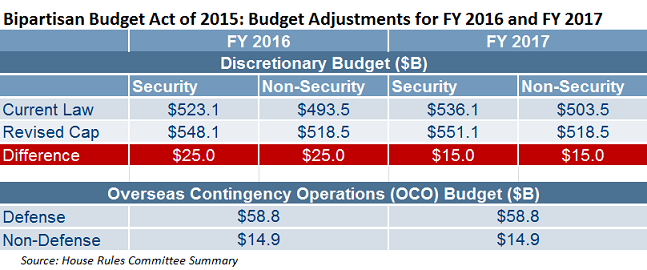New Two-Year Bipartisan Budget Deal – A Rising Tide Lifts All Boats
Published: October 27, 2015
BudgetCONGRESSForecasts and SpendingPolicy and LegislationSequestrationWHITE HOUSE OFFICE (EXECUTIVE OFFICE OF THE PRESIDENT)
A two-year budget agreement between Congressional leaders and the White House has been reached. If passed by the full Congress it would increase spending and remove the specter of the debt ceiling, sequestration, and government shutdowns until after the 2016 elections.
The Bipartisan Budget Agreement of 2015 (BBA) has been a goal for outgoing Speaker John Boehner before he leaves office at the end of October and appears to offer something for most interested parties on both sides of the aisle and at both ends of Pennsylvania Avenue.
Federal Spending and Related Provisions
The BBA increases federal discretionary spending by $80 billion over the next two years – FY 2016 and FY 2017 – and is divided equally between Security (defense, national security, and intelligence) and Non-Security (domestic) programs. The BBA also sets minimum adjustments to the defense and non-defense caps for overseas contingency operations (OCO) in these same fiscal years providing certainty for two years on approximate OCO levels. (See table below.)

The spending increases would be offset by savings from flattening Social Security disability benefits – along with reducing waste, fraud, and abuse – and a 2% cut to Medicare payments to doctors and other health care providers. But these measures are reported to avert much more drastic changes that would occur under current law if Congress takes no action in these areas. Other budgetary effects include an authorization of sales from the Strategic Petroleum Reserve to reduce budget deficits in future years.
The BBA also raises the federal debt ceiling to avoid hitting the current $18.1 trillion debt limit, which the Treasury Department has said would occur on Nov. 3, 2015. The new agreement would increase the federal borrowing limit through March 15, 2017.
Other Provisions
As is often the case with such negotiated agreements, the BBA includes various other provisions that may or may not be directly related to the federal budget. The bill would repeal Affordable Care Act’s requirement that employers with more than 200 employees to automatically enroll new full-time employees into a qualifying health plan if offered by that employer, and to automatically continue enrollment of current employees. The bill also includes sections addressing the management and auction of federal spectrum, changes to federal tax compliance laws, and provisions to clarify business partnership rules. It even has a section on designating the small House Rotunda as the “Freedom Foyer.”
Prospects and Impacts
For its part, the White House threw its endorsement behind the proposal. In a White House blog post, Jason Furman, Chairman of the Council of Economic Advisers, touted the expected economic benefits of the agreement, including job growth resulting from easing of sequester limits and the increased fiscal certainty that results from removing the specter of the debt ceiling and government shutdowns.
Members across the Hill have “likes” and “dislikes” within the BBA and while the bill text is now publicly available, the language still needs to be voted upon and it is possible that we may see some items that will need to be ironed out across the chambers. That said, since its announcement momentum appears to be growing to push it through, as you might expect from watching similar agreements in the past.